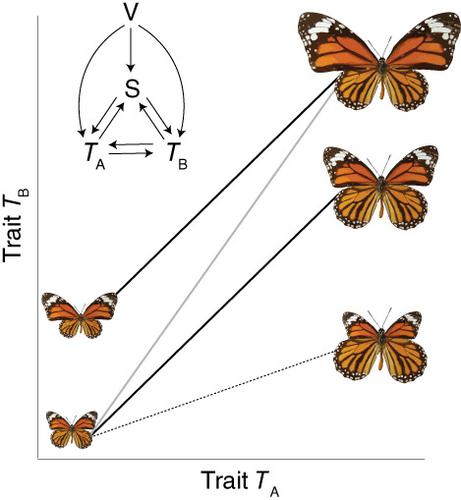当前位置:
X-MOL 学术
›
WIREs Mech. Dis.
›
论文详情
Our official English website, www.x-mol.net, welcomes your
feedback! (Note: you will need to create a separate account there.)
Network‐regulated organ allometry: The developmental regulation of morphological scaling
WIREs Mechanisms of Disease ( IF 4.6 ) Pub Date : 2020-06-21 , DOI: 10.1002/wdev.391 Isabelle M Vea 1 , Alexander W Shingleton 1
WIREs Mechanisms of Disease ( IF 4.6 ) Pub Date : 2020-06-21 , DOI: 10.1002/wdev.391 Isabelle M Vea 1 , Alexander W Shingleton 1
Affiliation

|
Morphological scaling relationships, or allometries, describe how traits grow coordinately and covary among individuals in a population. The developmental regulation of scaling is essential to generate correctly proportioned adults across a range of body sizes, while the mis‐regulation of scaling may result in congenital birth defects. Research over several decades has identified the developmental mechanisms that regulate the size of individual traits. Nevertheless, we still have poor understanding of how these mechanisms work together to generate correlated size variation among traits in response to environmental and genetic variation. Conceptually, morphological scaling can be generated by size‐regulatory factors that act directly on multiple growing traits (trait‐autonomous scaling), or indirectly via hormones produced by central endocrine organs (systemically regulated scaling), and there are a number of well‐established examples of such mechanisms. There is much less evidence, however, that genetic and environmental variation actually acts on these mechanisms to generate morphological scaling in natural populations. More recent studies indicate that growing organs can themselves regulate the growth of other organs in the body. This suggests that covariation in trait size can be generated by network‐regulated scaling mechanisms that respond to changes in the growth of individual traits. Testing this hypothesis, and one of the main challenges of understanding morphological scaling, requires connecting mechanisms elucidated in the laboratory with patterns of scaling observed in the natural world.
中文翻译:

网络调节器官异速生长:形态尺度的发育调控
形态缩放关系或异基因组学描述性状如何在种群中的个体之间协调和共变。缩放的发育调节对于在各种体型中产生正确比例的成年人至关重要,而缩放的错误调节可能导致先天性出生缺陷。几十年来的研究已经确定了调节个体特征大小的发育机制。尽管如此,我们仍然对这些机制如何协同工作以产生响应环境和遗传变异的性状之间的相关大小变异知之甚少。从概念上讲,形态尺度可以通过直接作用于多个生长性状的大小调节因素(特质自主尺度)产生,或间接通过中枢内分泌器官产生的激素(系统调节的缩放),并且有许多此类机制的成熟例子。然而,很少有证据表明遗传和环境变异实际上作用于这些机制以在自然种群中产生形态尺度。最近的研究表明,正在生长的器官本身可以调节体内其他器官的生长。这表明性状大小的协变可以通过响应个体性状增长变化的网络调节缩放机制产生。测试这一假设,以及理解形态缩放的主要挑战之一,需要将实验室中阐明的机制与自然界中观察到的缩放模式联系起来。
更新日期:2020-06-21
中文翻译:

网络调节器官异速生长:形态尺度的发育调控
形态缩放关系或异基因组学描述性状如何在种群中的个体之间协调和共变。缩放的发育调节对于在各种体型中产生正确比例的成年人至关重要,而缩放的错误调节可能导致先天性出生缺陷。几十年来的研究已经确定了调节个体特征大小的发育机制。尽管如此,我们仍然对这些机制如何协同工作以产生响应环境和遗传变异的性状之间的相关大小变异知之甚少。从概念上讲,形态尺度可以通过直接作用于多个生长性状的大小调节因素(特质自主尺度)产生,或间接通过中枢内分泌器官产生的激素(系统调节的缩放),并且有许多此类机制的成熟例子。然而,很少有证据表明遗传和环境变异实际上作用于这些机制以在自然种群中产生形态尺度。最近的研究表明,正在生长的器官本身可以调节体内其他器官的生长。这表明性状大小的协变可以通过响应个体性状增长变化的网络调节缩放机制产生。测试这一假设,以及理解形态缩放的主要挑战之一,需要将实验室中阐明的机制与自然界中观察到的缩放模式联系起来。











































 京公网安备 11010802027423号
京公网安备 11010802027423号